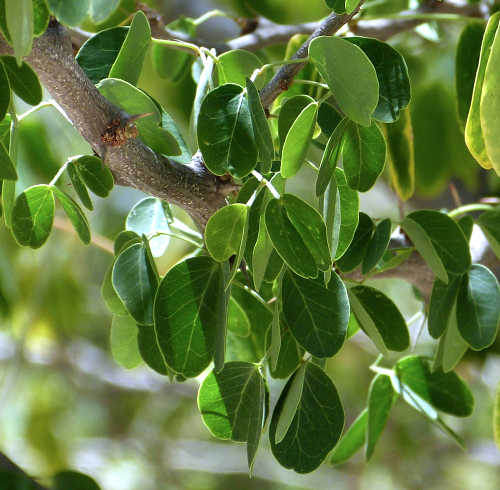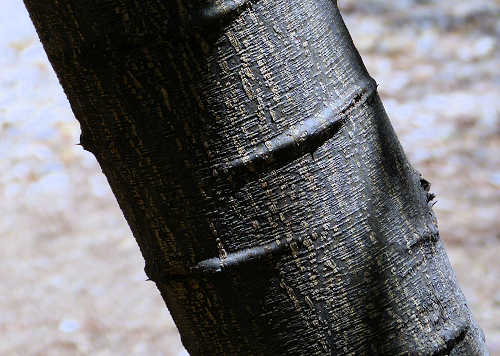Growing Guamuchil:
Pithecellobium dulce
Back to Fruit, Berries and Nuts
Botanical Overview
The Pithecellobium genus is a group of 75 plant species, with curled bean pods, belonging to the Legume family (Fabaceae). One of its better known species is Pithecellobium dulce, Guamuchil, with edible bean pod pulp.
Description
Form:
A tree with a spreading habit.
Lifespan:
50-150 years.
Leaf retention:
Semi-evergreen, with new leaves quickly replacing old ones as they drop, once a year.
Growth rate:
Rapid.
Mature Size:
20-30' (6-9m) high with a spreading habit.
Flowers:
White to cream, fragrant, frizzy puffballs, 1/2" (1.27cm) across.
Bloom:
Spring.
Self-fruitful:
Yes.
Years before fruiting:
4, grown from seed in optimal conditions.
Fruit:
A curly, knobby bean pod with a thin, brittle shell. The white to red popcorn-like filling,
surrounding 5-12 shiny, edible black beans, has a sweet-tart flavor variously described as
apple-coconut or dried pineapple-peach. It is used to make a drink similar to lemonade.
Months for fruit to ripen:
2-4. The pod is ripe when it reddens and splits open. As the split widens, the seed and its
surrounding pulp, attached by a cord-like structure, fall out, displaying the seed to birds
and tree climbing animals.
Storage after harvest:
After pod splitting, the pulp can be consumed immediately or allowed to dry a few days before
being used. The flavor can be more intense when the pulp is dried.
Leaves:
Green, oval, in groups of four leaflets, with thorns at their base. Dense shade.
Stems:
The trunk and branches are thorny, especially when young, with irregular branching. The
bark is initially gray to gray-brown, and over many years becomes rough, furrowed and
eventually peeling. The branches are susceptible to breakage in strong winds.
Roots:
An initial seedling tap root is followed by nitrogen fixing, aggressive, lateral roots that
dominate the root system of the mature tree. Injury to the roots results in thorny suckering.
After five years in the ground, the tree may regrow from its roots in severe freezes.
Wildlife:
The flowers attract honeybees. The tree is a caterpillar food plant for some species of
butterflies and moths. Birds and climbing animals may be attracted to the open pods and
their contents.
Toxic / Danger:
Thorns. The sap and bark can cause severe eye irritation.
Origin:
Coastal regions from Mexico through Central America into adjacent South America.
Cultivation and Uses
USDA hardiness zones:
10-11. It may die in freezes when young.
Chill hours:
None.
Heat tolerant:
Yes.
Drought tolerant:
Yes, when mature.
Sun:
Full sun. This plant is shade intolerant when young.
Planting:
Plant in the first half of spring before high temperatures arrive, in full sun, in an area
where it can grow to its natural size without pruning. It should have 12-15' (3.7-4.5m)
clearance on all sides. A south-west exposure is best to minimize winter freezes.
Soil:
Guamuchil is tolerant of soil types, and moderately saline tolerant.
Fertilize:
Do not use a fertilizer containing nitrogen because the roots of this plant are nitrogen
fixing.
Water after becoming established:
Deep water every few weeks.
First Year Care:
Protect from freezing in the first three years, including using winter mulch.
Deep water every 1-3 days in summer and twice a month in winter.
Keep other plants and grass away from its root area.
Prune:
This plant is somewhat thorny and pruning substantially increases the thorniness.
Older trees seem to have fewer thorns.
It can be pruned as a hedge by cutting close to the ground (coppicing), causing it to turn
very thorny and becoming a livestock barrier.
Litter:
Leaf fall during annual leaf changeover, bean pods.
Propagation:
Rooted cuttings, cuttings grafted onto seedling rootstock. Seed germinates quickly, but
is only viable for six months and does not grow true to its parent.
Uses:
Light shade, edible bean pod filling and beans, barrier hedge. The bean pods are used
as animal feed. The seeds produce a green oil for culinary use or soap making.
To make guamuchil syrup, simmer the guamuchil pulp in one cup (237ml) water plus one cup (237ml) sugar for a few minutes and then allow to cool. Add to ice water for a refreshing drink. The guamuchil flavor dissolves better in hot water than alcohol, which can be later mixed with the syrup.
To make guamuchil syrup, simmer the guamuchil pulp in one cup (237ml) water plus one cup (237ml) sugar for a few minutes and then allow to cool. Add to ice water for a refreshing drink. The guamuchil flavor dissolves better in hot water than alcohol, which can be later mixed with the syrup.
Comments
Pithecellobium dulce means "sweet monkey earring".
Look carefully at the left side of the trunk in the bottom picture and you will see two
small thorns. Four others are also visible, one as a shadow.
This plant is distantly related to other Legume family plants with edible bean pods or
filling, such as Carob,
Pacay, and
Tamarind.
Do you have additional information or a different experience for these plants that you would like to share? Email info@GardenOracle.com. All contributions are welcome and appreciated.
Do you have additional information or a different experience for these plants that you would like to share? Email info@GardenOracle.com. All contributions are welcome and appreciated.






Latest update: August, 2024
© 2008-2025 by GardenOracle.com

